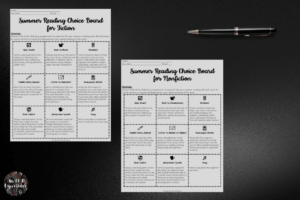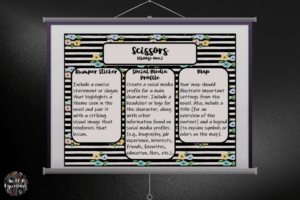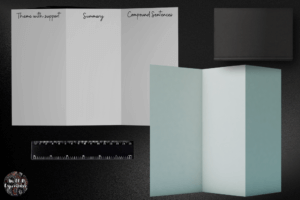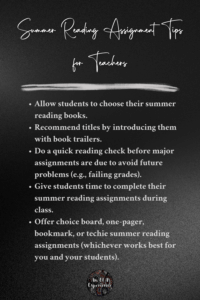Bid farewell to boring summer reading assignments! This post offers practical activities for making reading assignments fun and engaging for all students, even middle schoolers!
Allow Students Choice

Whether students are choosing a topic to write about or a book to read, you’ll notice that choice fosters buy-in, ownership, and motivation, so let them choose their summer reading titles.
Over the years, as both a student and a teacher, I’ve been required to read specific titles (too many to count). Except for once.
I was attending a professional development session on literature circles, and we were directed to choose one book from a list of five. Imagine my delight! I felt motivated, so motivated that I read the book in a day. (The book was The Help, not a psychological thriller as I would normally choose, but definitely an anxiety-producing read.)
This is one way to allow choice. Give students a list of titles to choose from.
But it’s not my favorite way. I prefer to let them choose any school-appropriate title they want to read.
When doing this, students will need guidance because you have both readers and nonreaders in your classrooms. To solve this problem, view and discuss book trailers or review annotated reading lists with them. As you do, ask them to note three titles they are interested in reading on an index card. They’ll have a title chosen by the end of the period! (For details on this lesson with a list of recommended books, visit “Blog Post #20: Great Summer Reading Lists for Teens to Plunge into Today.”)
A Quick Summer Reading Assignment to See Who Read a Book
Alphabet Reading Check

Even when summer reading is an assignment for the highest-performing students, not all will read during the summer. This can be a problem, especially when this assignment is the first major grade you’re taking for a new school year. To nip this in the bud, try this activity. It’s quick and challenging, and it will let you know who read during the summer. This, in turn, will give you the opportunity to conference with students and contact parents as needed before major summer reading assignments are due.
How-To
- Each student will need one index card with a letter from the alphabet on it. (Use all letters, except for X and Z. You can write them on the cards, stick letters on them, or purchase and print my handouts.) Walk around the room and have each student draw a card without seeing the letter.
- After each student has a card, have them write their names and book information (title and author) on the back of the card. On the front of the card, ask them to think of a word that begins with their assigned letter and connects to the novel. They will then write a paragraph that explains that connection.
- Before they start writing, model the process with a novel you read.
- If any students are stumped and can’t think of a word, then allow them to draw another card once more. This will help them (unless they haven’t read their summer reading book.) You will also find it helpful to allow a few volunteers to share their ideas for this assignment.
Of course, summer reading should be completed during the summer, and I don’t want to lower standards. However, I suggest making the assignments due a couple of weeks after school begins. This will help every student find success and allow new students time to complete the reading and assignments.
Summer Reading Assignments
Summer Reading Choice Boards
Choice boards are a great way to differentiate, increase student engagement, and appeal to different learning styles. As a fan of giving students choice, these are my favorite of the summer reading assignments I’ve offered over the years. Here are two I’ve used.
A Writing Summer Reading Choice Board

At the end of one school year, our ELA team decided to shorten the summer reading assignment because we didn’t feel like we had enough class time to thoroughly cover the curriculum. (Our hour-and-a-half blocks had been cut to forty-five minutes to teach reading and writing and to prepare students for two state tests.)
For this reason, we created one choice board for fiction and another for nonfiction. Both choice boards required students to choose and complete one writing assignment.
The advantage to this is it’s short and sweet. You’ll spend one day on summer reading assignments rather than five days. The disadvantage is that it doesn’t appeal to a variety of learning styles.
How-To
- At the top of the page, type a title, a space for a due date, and directions.
- Insert a table with nine cells onto a document or slide and stretch the table to fit the page.
- Type one writing assignment of equal difficulty (e.g., journal entries from the main character’s point of view, newspaper articles about significant events, a slideshow presentation that discusses themes, etc.) into each cell.
A Choice Board that Appeals to Various Learning Styles

This choice board asks students to choose and complete three assignments. Students come up with some remarkable products, and it appeals to different learning styles. Plus, if you are short on time, you can modify the number of assignments you expect students to complete.
How-To
- For this choice board, create a menu with points that add up to one hundred.
- Begin with three choices of easier assignments worth twenty points each (e.g., a bumper sticker with a theme, a social media profile for a character, etc.).
- Move to more difficult assignments, again offering three choices (e.g., a book jacket, a movie poster, etc.) worth thirty points each.
- Finally, end with the most difficult assignments at fifty points each (e.g., a scrapbook, trading cards, etc.).
- Students choose and complete one assignment from each section.
Summer Reading One-Pagers

A summer reading one-pager allows students to use their creativity and critical thinking skills to showcase their understanding of a book. Plus, students like them because they only require one page!
How-To
- Demonstrate what you expect students to accomplish by showing them examples of one-pagers. (Chomping at the Lit offers some beautiful samples. After you complete the activity with one class, you can use your students’ work for examples.)
- Instruct students to include images (e.g., symbols that represent the book) and words (e.g., themes, summaries, character traits, plot details, supporting quotes, etc.)
- Allow them to work with a template or a blank sheet of paper (their choice).
- If you want to hit a particular objective with the one-pager assignment, you can do that too. Take theme for an example. Students can include images and information that relate to a theme (or multiple themes) in their novel: topics, the theme itself, explanations of how themes are developed, and text-to-self, text, or world connections. Just make sure to review theme with them before you try this.
Bookmarks for Summer Reading

Another practical summer reading assignment is to have students create their own bookmarks with trifolds or eight-page books.
How-To
- For the front of the bookmark, they can redesign the book’s cover. For the remaining pages, ask them to include whatever you want to assess (e.g., themes, summaries, literary devices, character traits, supporting quotes, sentences with specific phrases or clauses, etc.).
How To Create a Trifold
- To create a trifold, fold a sheet of paper into thirds as you would a letter.
How To Create an Eight-Page Book
- Fold the paper in half three times hamburger style,
- return to the first fold,
- cut in the center on the folded side up to the crease,
- return to an unfolded sheet,
- fold the paper hotdog style, push the two ends together, and fold it into a book shape.
Whichever you choose, model the book-folding process for students.
Techie Summer Reading Assignments

Although 2020 caused many teachers to move away from technology use in the classroom, it has its advantages: student engagement, real-world learning, using it for instructional purposes, etc.
With this in mind, if you have computers for every student, consider a technology choice board for summer reading assignments. Here are a few my students have had success with.
- Novel-related infographics and collages with Canva. (Age restrictions apply for students under thirteen, but they can sign up for an account with parental permission.)
- Virtual museums with Slidesmania.
- Games on Kahoot. (In the U.S., there are age restrictions for students under 13. Also, it’s free for students and $3.99 a month for teachers.)
Sharing Summer Reading Assignments
Line Share
When their hard work is finished, many students will be excited to share it. One way I like to do this is with a line share. It doesn’t take much time, and it allows students to share their projects with multiple peers.
How-To
- Have your students choose one part of their summer reading assignments to present to others.
- Ask them to form two lines with one line facing the other.
- Give them around five minutes to share their projects with their partners.
- When the allotted time has ended, have one line move one spot up with the person at the front of that line moving to the back.
- Allow them five minutes to share with their new partner.
- Repeat the last two steps a few times.
Related Articles for Summer Reading Assignments
If you’d like a little help motivating students to read during the summer, visit “Blog Post #20: Great Summer Reading Lists for Teens to Plunge into Today.” Along with recommended middle school titles it includes links to Amazon, book trailers, and library associations.
If you’re interested in summer reading choice boards, slides with directions and graphic organizers for students, visit “Summer Reading Choice Boards” in my store.
Summer Reading Assignments in a Nutshell

- Allow students to choose their summer reading books.
- Recommend titles by introducing them with book trailers.
- Do a quick reading check before major assignments are due to avoid future problems (e.g., failing grades).
- Give students class time to complete their summer reading assignments.
- Offer choice board, one-pager, bookmark, or techie summer reading assignments (whichever works best for you and your students).
Thank you so much for reading! Please drop me a line in the comment section below to let me know what your students think of these summer reading assignments!


